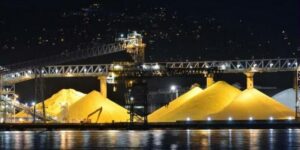
Preface. I first learned of sulfur’s existence when my grandmother told me how she loved going to tent revivals on the edge of town where it was common for preachers to get converts by burning sulfur to make the fire and brimstone damnation of Hell seem real (during the 3rd Great Awakening).
Alice Friedemann www.energyskeptic.com Author of Life After Fossil Fuels: A Reality Check on Alternative Energy; When Trucks Stop Running: Energy and the Future of Transportation”, Barriers to Making Algal Biofuels, & “Crunch! Whole Grain Artisan Chips and Crackers”. Women in ecology Podcasts: WGBH, Jore, Planet: Critical, Crazy Town, Collapse Chronicles, Derrick Jensen, Practical Prepping, Kunstler 253 &278, Peak Prosperity, Index of best energyskeptic posts
***
Sulfuric acid is called the “king of chemicals” because it is the most widely used chemical on earth. Over 260 million metric tons were produced in 2021 for lead acid batteries, chemicals, detergent, rayon, paper, iron and steel pickling, glass, cement, adhesives, sugar refining, fireworks, rubber vulcanization, explosives, pesticides, drugs, plastics, pigments, water treatment, and 30,000 other products. Sulfuric acid is also used at mines and smelters to produce copper, zinc, cobalt, lead, and nickel can also be used to extract metals.
Sulfuric acid is also essential for electric vehicles, batteries, solar, wind turbines, semiconductors and other green technology, because sulfuric acid is how you get lithium, cobalt, nickel, copper, and some rare earth metals by dissolving the rock around them.
But over half is used for the most important product of all, dissolving phosphate out of rocks to make phosphate fertilizer, which can increase crop production by 50%, to grow our fuel: food. And not only that, but to make the universal energy currency of all life on earth, Adenosine tri-phosphate (ATP) which powers all cells. Plus, all living creatures are part phosphate, it’s in our DNA, RNA, cell membranes, bones, and teeth.
Yet sulfuric acid shortages loom in the future, even though sulfur is the fifth most common element in the world! So how on earth could there ever be a sulfur shortage?
It may be common, but deposits large enough to exploit are extremely rare, mostly near volcanoes. Most sulfur or sulfates are combined with copper, iron, lead, zinc, barium, calcium (aka gypsum), magnesium, and sodium.
Today 80% comes from oil and natural gas refining into pure elemental sulfur, safe and easy to transport, unlike sulfuric acid, and with the bonus of preventing sulfur dioxide emissions and acid rain.
But there are scientists warning about 25 years of conventional oil left in the world at current rates of consumption. Others say more than that. But whatever the amount left, exponential growth from population and capitalism shortens consumption time.
The remaining 20% is mainly gotten by the Frasch process which requires dumping lots of super heated water into boreholes drilled into sulfur bearing rocks, water boiled by fossils today, vast amounts of wood in the future. This method releases not just sulfuric acid but toxic metals like arsenic, mercury, lead, cadmium, and chromium that can leach out for millennia, poisoning rivers and groundwater. Dozens of the 1,334 U.S. EPA superfund sites are abandoned copper, zinc, and sulfur mines, are still leaching sulfuric acid and poisonous metals decades later (EPA 2022).
The U.S. was the leading manufacturer of the world’s sulfur before fossil fuels by drilling down 500 to 3,000 feet into the sulfur-bearing deposits of the gulf coast using the Frasch process (GGFC 2015).
Sulfuric acid is difficult and expensive to transport. It’s potentially lethal, unlike elemental sulfur that can safely and easily be delivered to where the sulfuric acid will be made.
Sulfur & Peak Food
Since green technology and other industries are more profitable than phosphate fertilizer, that may drive food production lower and prices higher as less fertilizer is made.
Not that there’s much more phosphorus to mine. Walan et al (2014) summarized 19 studies that estimated world peak phosphate production — or total depletion — in 30 to 400 years at current rates of consumption. Morocco has a whopping 75% or more of remaining phosphate reserves in a contested area, increasing geographical supply chain and instability risks.
The US has about 25 years left of phosphate reserves, 65% of it in Florida. The center for biological diversity reports that strip mining phosphate rock is an ecological disaster. Thousands of acres have been cleared and dug out to get at the phosphate ore 60 to 80 feet blow ground. The ore is taken to clay settling ponds that further destroy many acres of habitat, and turned into fertilizer with sulfuric acid. Which in turn has created over a billion tons of radioactive waste (phosphogypsum) stored in 25 stacks above the Florida aquifer that provides the drinking water for 10 million people. And there are plans to tear up 50,000 more acres (CBD 2021).
But don’t worry, Governor DeSantis has come up with a way to dispose of it: “A new law is paving the way for radioactive roads in Florida. But environmentalists say it would affect road construction workers, harm plant and wildlife, and potentially kill precious Florida springs.”
You’d think that something so essential for all life on earth would be recycled, but it isn’t. Research is being done, but meanwhile it’s too expensive. Although some sewage sludge was dumped on farms, this turned out to be a disaster since sludge is full of microplastics, heavy metals, antibiotics and other toxins. No wonder recycling phosphorous from it is hard to do.
Sulfur in Food Preservation
Sulfites have been used for centuries as a food preservative and are still is used in wine, soft drinks, dried fruits and vegetables, salami, sausage, and more (UFA 2021). When refrigeration ends, they will become far more important to keep food from spoiling.
